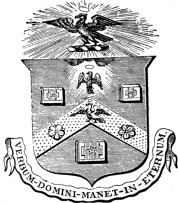Date of formation 1403 (1403) Master of company Ian Bennett | Order of precedence 47th | |
 | ||
Location Stationers' Hall, London Company association Printing and publishing Motto Verbum Domini Manet In Aeternum | ||
The Worshipful Company of Stationers and Newspaper Makers (until 1937 the Worshipful Company of Stationers), usually known as the Stationers' Company, is one of the Livery Companies of the City of London. The Stationers' Company was formed in 1403; it received a Royal Charter in 1557. It held a monopoly over the publishing industry and was officially responsible for setting and enforcing regulations until the enactment of the Statute of Anne in 1710. Once the Company received its Charter, “the Company’s role was to regulate and discipline the industry, define proper conduct and maintain its own corporate privileges.”
Contents
Its members (Master, Wardens, Assistants, Liverymen, Freemen and Apprentices) are mostly involved with the modern visual and graphic communications industries which have evolved from the company's original trades. These include printing, papermaking, packaging, office products, engineering, advertising, design, photography, film and video production, publishing of books, newspapers and periodicals and digital media. The Company's principal purpose nowadays is to provide an independent forum where its members can advance the interests (strategic, educational, training and charitable) of the industries associated with the Company.
History
In 1403, the Corporation of London approved the formation of a Guild of Stationers. At this time, stationers were either text writers, lymners (illuminators), bookbinders or booksellers who worked at a fixed location (stationarius) beside the walls of St Paul's Cathedral. Booksellers sold manuscript books, or copies thereof produced by their respective firms for retail; they also sold writing materials. Illuminators illustrated and decorated manuscripts.
Printing gradually displaced manuscript production so that, by the time the Guild received a Royal Charter of Incorporation on 4 May 1557, it had in effect become a Printers' Guild. In 1559, it became the 47th in City Livery Company precedence. At the time, it was based at Peter's College, which it bought from St Paul's Cathedral. During the Tudor and Stuart periods, the Stationers were legally empowered to seize "offending books" that violated the standards of content set down by the Church and State; its officers could bring "offenders" before ecclesiastical authorities, usually the Bishop of London or the Archbishop of Canterbury depending on the severity of the transgression. Thus the Stationers played an important role in the culture of England as it evolved through the intensely turbulent decades of the Protestant Reformation and toward the English Civil War.
The Stationers' Charter, which codified its monopoly on book production, ensured that once a member had asserted ownership of a text (or "copy") no other member was entitled to publish it. This is the origin of the term "copyright", but which is a distinctly different right to our modern conception of copyright (ie the stationers' 'copy right' was a protection granted to printers, where 'copyright', introduced with the Statute of Anne is a right granted to authors). Members asserted such ownership by entering it in the "entry book of copies" or the Stationers' Company Register. The Register of the Stationers' Company became one of the most essential documentary records in the later study of English Renaissance theatre. (In 1606 the Master of the Revels, who was responsible for licensing the performance of plays rather than their publication, acquired some overlapping authority over publication as well; but the Stationers' Register remained a crucial and authoritative source of information after that date too.) To be sure, enforcement of the rules was always a challenge, in this area as in other aspects of the Tudor/Stuart regime; and plays and other works were sometimes printed surreptitiously and illegally.
In 1603, the Stationers formed the English Stock, a joint stock publishing company funded by shares held by members of the Company. This profitable business gained many patents of which the richest was for almanacks including Old Moore's Almanack. The business employed out-of-work printers and disbursed some of the profit to the poor.
In 1606, the Company bought Abergavenny House in Ave Maria Lane and moved out of Peter's College. The new hall burnt down in the Great Fire of 1666 along with books to the value of about £40,000. It was rebuilt and its present interior is much as it was when it reopened in 1673. The Court Room was added in 1748 and in 1800 the external façade was remodelled to its present form.
In 1695, the monopoly power of the Stationers' Company was diminished, and in 1710 Parliament passed the Copyright Act 1709, the first copyright act.
The Company established the Stationers' Company's School at Bolt Court, Fleet Street in 1861 for the education of sons of members of the Company. In 1894, the school moved to Hornsey in north London. It closed in 1983.
Registration under the Copyright Act 1911 ended in December 1923; the Company then established a voluntary register in which copyrights could be recorded to provide printed proof of ownership in case of disputes.
In 1937, a Royal Charter amalgamated the Stationers' Company and the Newspaper Makers' Company, which had been founded six years earlier (and whose members were predominant in Fleet Street), into the Company of the present name.
The Company's motto is Verbum Domini manet in aeternum, Latin for The Word of the Lord endures forever.
Stationers' Hall
Stationers' Hall is at Ave Maria Lane near Ludgate Hill. The site of the present hall was formerly Abergavenny House, which was purchased by the Stationers in 1606 for £3,500, and destroyed in the Great Fire of London, 1666. The building and hall date from circa 1670. The hall was remodelled in 1800 by the architect Robert Mylne and, on 4 January 1950, it was designated a Grade I listed building.
